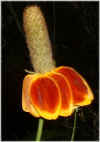|
|
||
|
|
Mexican Hat
|
|
|
Detailed Wildflower Profiles Site Map
Home |
As stated above, Mexican hat is an incredibly easy to grow plant. Throw some seed on the ground, scratch it in, and wait for the show! It transplants well, blooms the first year, and thrives on neglect. It is a mainstay in many perennial and wildflower mixes, and like many of it's cousins, as long as it is in a well-drained and sunny position, it will happily put on a long, colorful show (approximately May - July).
Being a close relative of the purple coneflower (Echinacea), which is a well-known medicinal plant, it's not surprising that historically Mexican Hat has also been used for its medicinal properties. The Indians boiled leaves and flowers to make a tea to use externally on snakebites and to reduce symptoms caused by poison ivy (see How to Make Herbal Teas for more information). They also apparently drank the tea for non-specified medical complaints, but since there is very little information available on this aspect of usage, we do not recommend using it internally at this time.
Custom Search
|
|
|
Gardens Ablaze |
||
 Mexican
Hat is a plant that many of us take for granted because it is such a common
sight virtually everywhere due to it's prolific seeding habit. However,
in the home wildflower or perennial garden, it is a delightful plant that
blooms freely over a long period, makes a great long-stemmed, interesting
cut flower, and does well in that hot, dry, poor-soil area that nothing
else seems to grow in. It is yet another
Mexican
Hat is a plant that many of us take for granted because it is such a common
sight virtually everywhere due to it's prolific seeding habit. However,
in the home wildflower or perennial garden, it is a delightful plant that
blooms freely over a long period, makes a great long-stemmed, interesting
cut flower, and does well in that hot, dry, poor-soil area that nothing
else seems to grow in. It is yet another
